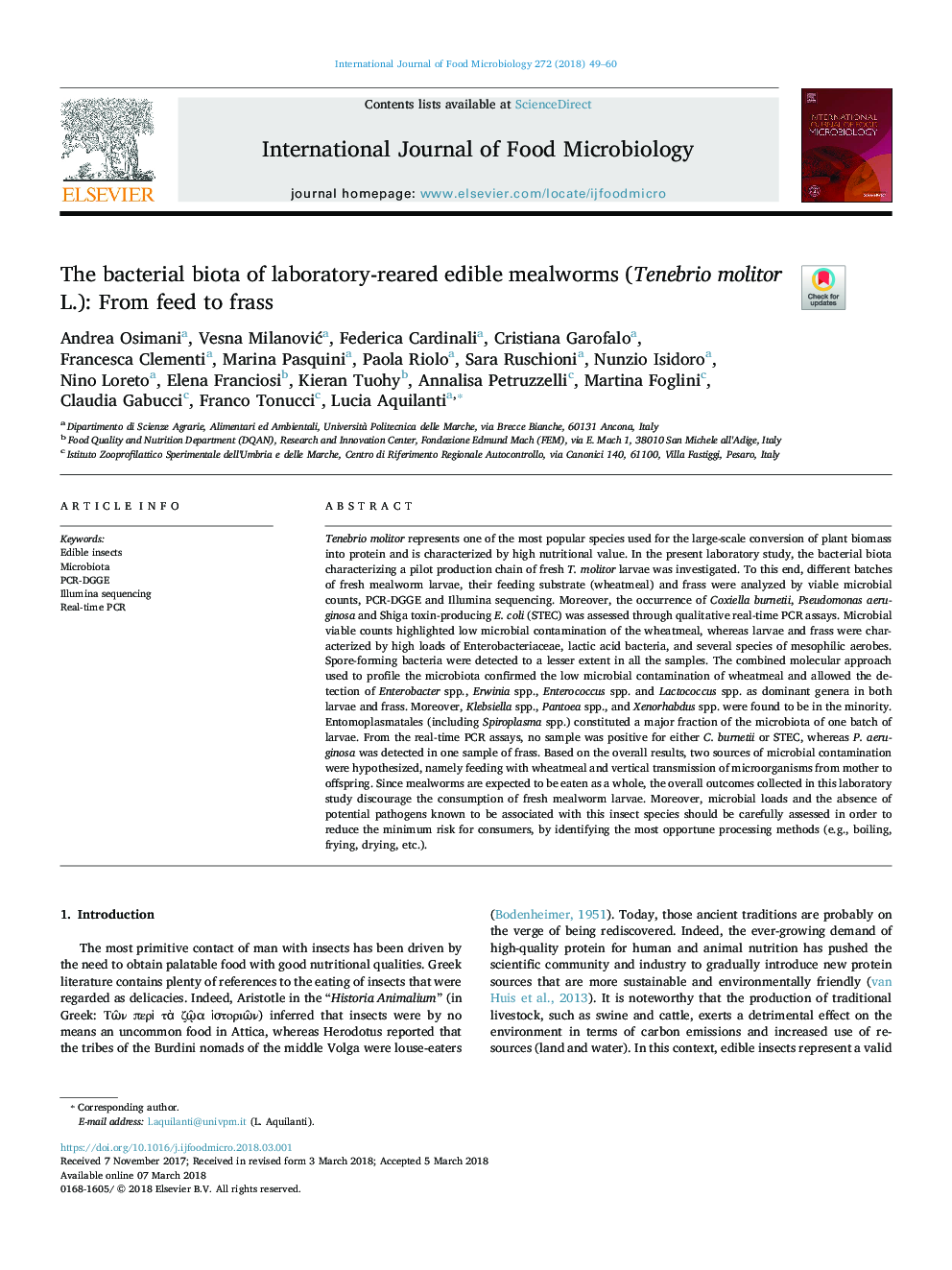| کد مقاله | کد نشریه | سال انتشار | مقاله انگلیسی | نسخه تمام متن |
|---|---|---|---|---|
| 8844231 | 1616511 | 2018 | 12 صفحه PDF | دانلود رایگان |
عنوان انگلیسی مقاله ISI
The bacterial biota of laboratory-reared edible mealworms (Tenebrio molitor L.): From feed to frass
دانلود مقاله + سفارش ترجمه
دانلود مقاله ISI انگلیسی
رایگان برای ایرانیان
کلمات کلیدی
موضوعات مرتبط
علوم زیستی و بیوفناوری
علوم کشاورزی و بیولوژیک
دانش تغذیه
پیش نمایش صفحه اول مقاله

چکیده انگلیسی
Tenebrio molitor represents one of the most popular species used for the large-scale conversion of plant biomass into protein and is characterized by high nutritional value. In the present laboratory study, the bacterial biota characterizing a pilot production chain of fresh T. molitor larvae was investigated. To this end, different batches of fresh mealworm larvae, their feeding substrate (wheatmeal) and frass were analyzed by viable microbial counts, PCR-DGGE and Illumina sequencing. Moreover, the occurrence of Coxiella burnetii, Pseudomonas aeruginosa and Shiga toxin-producing E. coli (STEC) was assessed through qualitative real-time PCR assays. Microbial viable counts highlighted low microbial contamination of the wheatmeal, whereas larvae and frass were characterized by high loads of Enterobacteriaceae, lactic acid bacteria, and several species of mesophilic aerobes. Spore-forming bacteria were detected to a lesser extent in all the samples. The combined molecular approach used to profile the microbiota confirmed the low microbial contamination of wheatmeal and allowed the detection of Enterobacter spp., Erwinia spp., Enterococcus spp. and Lactococcus spp. as dominant genera in both larvae and frass. Moreover, Klebsiella spp., Pantoea spp., and Xenorhabdus spp. were found to be in the minority. Entomoplasmatales (including Spiroplasma spp.) constituted a major fraction of the microbiota of one batch of larvae. From the real-time PCR assays, no sample was positive for either C. burnetii or STEC, whereas P. aeruginosa was detected in one sample of frass. Based on the overall results, two sources of microbial contamination were hypothesized, namely feeding with wheatmeal and vertical transmission of microorganisms from mother to offspring. Since mealworms are expected to be eaten as a whole, the overall outcomes collected in this laboratory study discourage the consumption of fresh mealworm larvae. Moreover, microbial loads and the absence of potential pathogens known to be associated with this insect species should be carefully assessed in order to reduce the minimum risk for consumers, by identifying the most opportune processing methods (e.g., boiling, frying, drying, etc.).
ناشر
Database: Elsevier - ScienceDirect (ساینس دایرکت)
Journal: International Journal of Food Microbiology - Volume 272, 2 May 2018, Pages 49-60
Journal: International Journal of Food Microbiology - Volume 272, 2 May 2018, Pages 49-60
نویسندگان
Andrea Osimani, Vesna MilanoviÄ, Federica Cardinali, Cristiana Garofalo, Francesca Clementi, Marina Pasquini, Paola Riolo, Sara Ruschioni, Nunzio Isidoro, Nino Loreto, Elena Franciosi, Kieran Tuohy, Annalisa Petruzzelli, Martina Foglini,